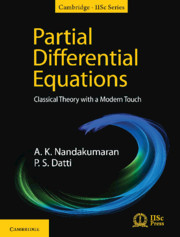Book contents
- Frontmatter
- Dedication
- Contents
- List of Illustrations
- Preface
- Acknowledgments
- Notations
- Chapter 1 Introduction
- Chapter 2 Preliminaries
- Chapter 3 First-Order Partial Differential Equations: Method of Characteristics
- Chapter 4 Hamilton–Jacobi Equation
- Chapter 5 Conservation Laws
- Chapter 6 Classification of Second-Order Equations
- Chapter 7 Laplace and Poisson Equations
- Chapter 8 Heat Equation
- Chapter 9 One-Dimensional Wave Equation
- Chapter 10 Wave Equation in Higher Dimensions
- Chapter 11 Cauchy–Kovalevsky Theorem and Its Generalization
- Chapter 12 A Peep into Weak Derivatives, Sobolev Spaces and Weak Formulation
- References
- Index
Chapter 8 - Heat Equation
Published online by Cambridge University Press: 20 May 2020
- Frontmatter
- Dedication
- Contents
- List of Illustrations
- Preface
- Acknowledgments
- Notations
- Chapter 1 Introduction
- Chapter 2 Preliminaries
- Chapter 3 First-Order Partial Differential Equations: Method of Characteristics
- Chapter 4 Hamilton–Jacobi Equation
- Chapter 5 Conservation Laws
- Chapter 6 Classification of Second-Order Equations
- Chapter 7 Laplace and Poisson Equations
- Chapter 8 Heat Equation
- Chapter 9 One-Dimensional Wave Equation
- Chapter 10 Wave Equation in Higher Dimensions
- Chapter 11 Cauchy–Kovalevsky Theorem and Its Generalization
- Chapter 12 A Peep into Weak Derivatives, Sobolev Spaces and Weak Formulation
- References
- Index
Summary
INTRODUCTION
The heat or diffusion equation
models the heat flow in solids and fluids. It also describes the diffusion ofchemical particles. It is also one of the fundamental equations that haveinfluenced the development of the subject of partial differential equations(PDE) since the middle of the last century. Heat and fluidflow problems are important topics in fluid dynamics. Here theheat flow is combined with a fluid flow problem and the resulting equationis termed as energy equation. We begin with a derivation ofone-dimensional heat equation, arising from the analysis of heat flow in athin rod. Further, equation (8.1) is also a prototype in the class ofparabolic equations and hence the importance of studying this equation.
Derivation of One-Dimensional Heat Equation
Consider a thin rod of length L and place it along thex-axis on the interval [0; L]. Weassume that the rod is insulated so that its lateral surface is impenetrableto heat transfer. We also assume that the temperature is the same at allpoints of any cross-sectional area of the rod. Let denote, respectively, themass density, heat capacity and the coefficient of (internal) thermalconductivity, of the rod. Let us analyze the heat balance in an arbitrarysegment [x1; x2] of the rod, with𝛿x = x2 −x1 very small, over a time interval[t, t + 𝛿t];𝛿t small (see Figure 8.1).
Let u(x, t) denote thetemperature in the cross-section with abscissax, at time t. According toFourier's law of heat conduction, the rate ofheat propagation q is proportional to , with
S denoting the area of the cross-section. Here,
where 𝛿Q is the quantity of heat that has passedthrough a cross-section S during a time𝛿t. Thus,
Applying Fourier's law at x1 andx2, we obtain
Thus, the quantity of heat that has passed through the small segment[x1, x2] of therod, during time 𝛿t is given by
This influx of heat during time 𝛿t was spent inraising or lowering the temperature of the rod by𝛿u, say.
- Type
- Chapter
- Information
- Partial Differential EquationsClassical Theory with a Modern Touch, pp. 216 - 251Publisher: Cambridge University PressPrint publication year: 2020
- 1
- Cited by



